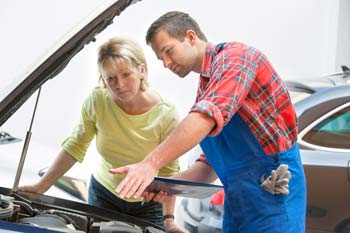How To Save Money on Car Repairs - Mechanic's Tips
Updated: July 01, 2022
Maintaining your car is not cheap, but there are always ways to save. We know how the automotive service industry works, so we wanted to share a few insider tips.
Parts don't always have to be changed in pairs
 Many parts in your car come in pairs.
Many parts in your car come in pairs. It's not a bad idea to have struts or shock absorbers in the same condition on both sides. But if you want to save money, ask the mechanic if it is safe to replace only the part that is bad and leave the other side for now. If it is, you can save up to several hundred dollars.
Not all services are equally important
 Prioritize services.
Prioritize services.For example, your service advisor tells you that your car needs new brakes, a new air filter and cooling system flush. If you ask these two questions, a service advisor will probably tell you that brakes are important for safety and the air filter and cooling system flush can wait.
When some part is recommended to be replaced, ask for details: How bad is it and how long can it last if you don't change it? You may find that your drive belt, while showing some discoloration, will probably last for a while longer, but your strut is leaking and is a safety concern that needs to be addressed ASAP.
The maintenance schedule will provide many answers
 Get a written estimate and do some research.
Get a written estimate and do some research. You can find it in the owner's manual or in a separate Warranty and Maintenance brochure.
For example, if the repair shop recommends new spark plugs, but your car is good on gas, runs like new and has only 50,000 miles, see what the Maintenance Schedule says.
You may find that, according to the maintenance schedule, your spark plugs need to be replaced only at 120,000 miles; which means that this service can wait.
If the shop recommends an "engine flush" and it's not even mentioned in your Maintenance Schedule, your car may not even need it; do some research. To help you, we posted explanations of many common services in this article.
Look for specialty shops
 Muffler shops can fabricate some exhaust parts on the spot.
Muffler shops can fabricate some exhaust parts on the spot.Muffler shops have more supplies and can fabricate some exhaust components on the spot or repair a broken part by welding. Often, their prices are reasonable.
If your windshield is cracked and you don't have insurance coverage for it, check with a local auto glass shop. Their prices are usually cheaper. If the original audio unit has failed and your car is out of warranty, consider installing an aftermarket audio unit at a local car electronics shop instead. It might be much cheaper than replacing it with an OEM unit.
Used parts
In some cases, used parts can be a good alternative. If you need a side mirror or taillight assembly or one of your alloy rims is damaged, check out local auto recycling facilities (auto wreckers).For example, one of our friends had one of the doors damaged in his car. The collision repair shop quoted him over $1,200 for repairs. He found a used door from a local auto wrecker. Even the color of the door matched his car. A local repair shop has replaced the door for him. The overall cost of repair was less than $600.
Auto recycling facilities sell many parts including used alternators starters, engines, transmissions, CV axles, etc.
Additives and upgrades
 Some additives can help with expensive problems.
Some additives can help with expensive problems.If your manual gear box grinds when shifting into a gear, it's probably because some of the synchronizers are worn out. Repairing it will be expensive. There are, however, special gear oils that can reduce grinding. It's worth trying before spending a couple of thousand on rebuilding the gear box.
There are engine oil additives that can help reduce oil consumption between oil changes. A fuel additive that costs $5-$15 can clean clogged fuel injectors; it's cheaper than doing the fuel injection service at a repair shop. Check reviews and ratings for the product you intend to use.
What if your Check Engine light came on
 Check Engine light.
Check Engine light.If the Check Engine light stays on, it means that there is a fault code stored in your vehicle computer. Some parts stores, like AutoZone offer to scan your vehicle for free and read the fault code. Once you know the code, you might be able to save some money. How?
Sometimes, the Check Engine light might be caused by something simple, like a gas cap that is not tight, or a loose battery cable clamp, or low oil level. For example, if a gas cap is not closed tight after filling up, it will most likely cause the trouble code P0455 that stands for Large EVAP leak.
Advertisement
Look up local parts stores that can scan your vehicle for free. You can even buy a simple code reader or scan tool that can read a fault code. A basic OBD-II scan tool costs around $50-$60.
Many repairs can be avoided
 Keep your oil level topped up.
Keep your oil level topped up. If you found that your oil was low and topped it up before a long trip, you might have saved hundreds of dollars because many engine problems are caused by running low on oil. Read more: How to check and top up your oil. Checking your car regularly and keeping all the fluids topped up pays off.
Some repairs can be done DIY
 Changing an air filter.
Changing an air filter.If you are ready to take on more serious repairs but don't have special tools, some auto parts stores (e.g. AutoZone) offer tool loan programs where you can borrow some special tools. If you need a repair guide, there are websites where you can buy instant access to a repair manual for your car: AlldataDIY.com, eAutoRepair.net, Chiltondiy.com
Power of secret warranties
 Warranty brochure.
Warranty brochure. First, it makes sense to check for recalls at the NHTSA website. Second, check owner forums dedicated to this make and model to see if someone had to deal with the same problem and if it was covered. Third, search for technical service bulletins related to the problem. Fourth, check with your dealer.
We know cases where car manufacturers approve certain out-of-warranty or "goodwill" repairs. They are more likely to do so if it's a safety-related problem and if your warranty has expired recently. Sometimes they may cover a portion of the repair cost. Your dealer can help you with the process.
Coupons, promotions and rewards
 Research coupons.
Research coupons.Some shops offer free wheel alignment when you buy a set of tires. Many dealers offer discounts on brake replacements and other services during off-peak seasons (e.g. January or February).
Many larger dealerships offer reward programs where a percentage of what you pay for parts and services gets credited towards your next service or vehicle purchase. If you plan to stay with the same dealer for many years, why not get some money back?



